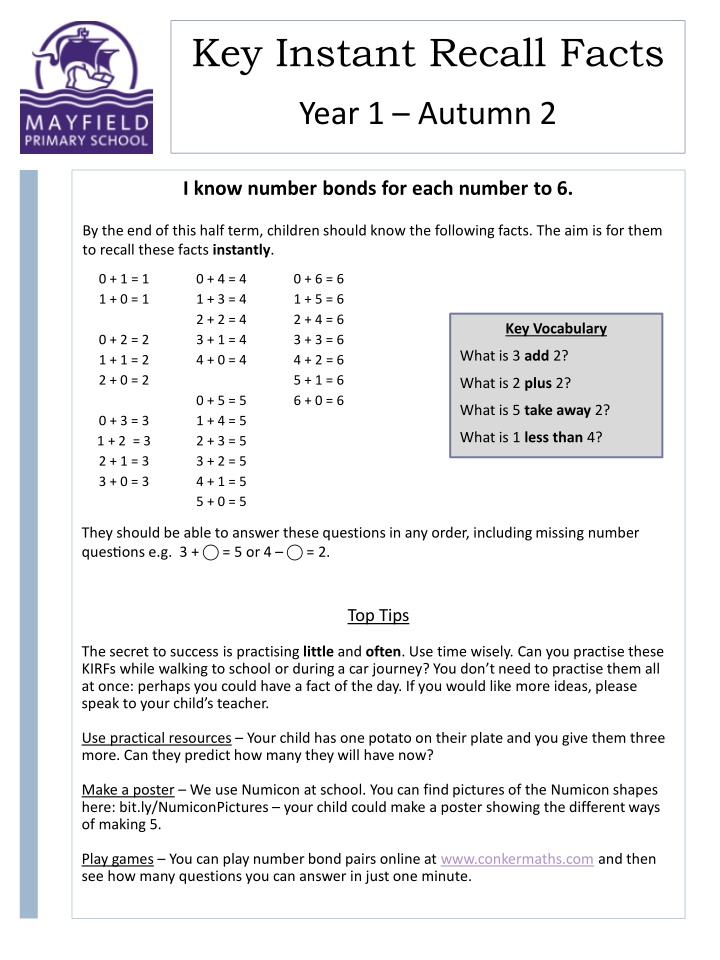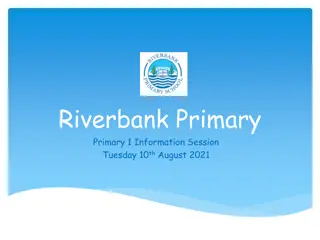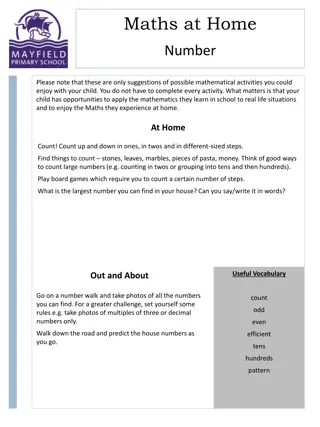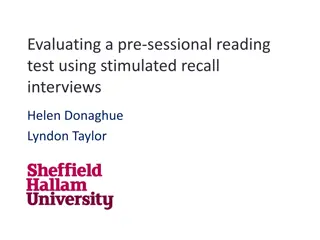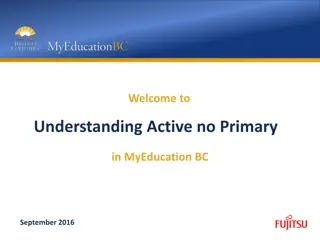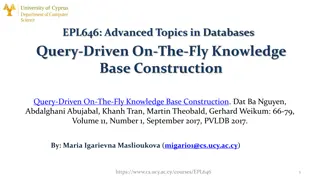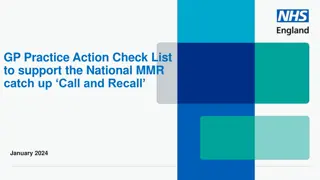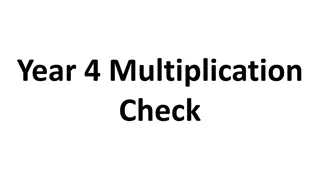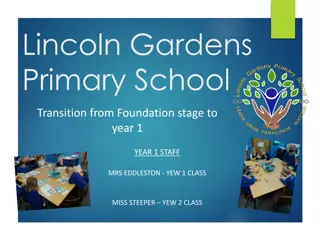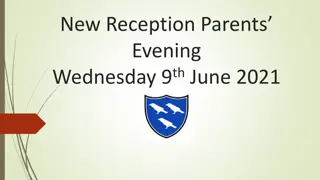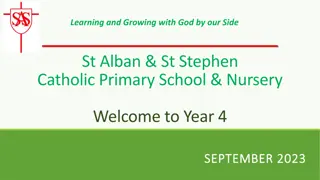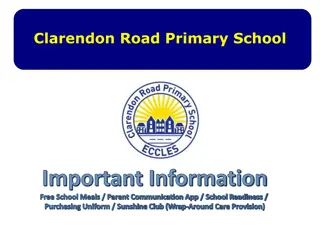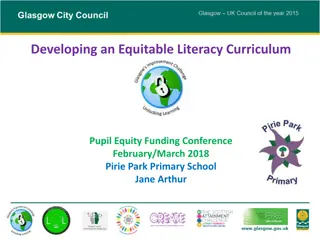Key Instant Recall Facts for Year 1 Students at Mayfield Primary School
Enhance your child's math skills with these key instant recall facts focusing on number bonds and doubles/halves up to 10. Practice regularly using practical resources, games, and online activities to help children recall these facts instantly. The provided tips and activities aim to make learning fun and engaging for young learners at Mayfield Primary School.
Download Presentation

Please find below an Image/Link to download the presentation.
The content on the website is provided AS IS for your information and personal use only. It may not be sold, licensed, or shared on other websites without obtaining consent from the author.If you encounter any issues during the download, it is possible that the publisher has removed the file from their server.
You are allowed to download the files provided on this website for personal or commercial use, subject to the condition that they are used lawfully. All files are the property of their respective owners.
The content on the website is provided AS IS for your information and personal use only. It may not be sold, licensed, or shared on other websites without obtaining consent from the author.
E N D
Presentation Transcript
Mayfield Primary School Key Instant Recall Facts Year 1 Autumn 2 I know number bonds for each number to 6. By the end of this half term, children should know the following facts. The aim is for them to recall these facts instantly. 0 + 1 = 1 1 + 0 = 1 0 + 4 = 4 1 + 3 = 4 2 + 2 = 4 3 + 1 = 4 4 + 0 = 4 0 + 6 = 6 1 + 5 = 6 2 + 4 = 6 3 + 3 = 6 4 + 2 = 6 5 + 1 = 6 6 + 0 = 6 Key Vocabulary 0 + 2 = 2 1 + 1 = 2 2 + 0 = 2 What is 3 add 2? What is 2 plus 2? 0 + 5 = 5 1 + 4 = 5 2 + 3 = 5 3 + 2 = 5 4 + 1 = 5 5 + 0 = 5 What is 5 take away 2? 0 + 3 = 3 1 + 2 = 3 2 + 1 = 3 3 + 0 = 3 What is 1 less than 4? They should be able to answer these questions in any order, including missing number questions e.g. 3 + = 5 or 4 = 2. Top Tips The secret to success is practising little and often. Use time wisely. Can you practise these KIRFs while walking to school or during a car journey? You don t need to practise them all at once: perhaps you could have a fact of the day. If you would like more ideas, please speak to your child s teacher. Use practical resources Your child has one potato on their plate and you give them three more. Can they predict how many they will have now? Make a poster We use Numicon at school. You can find pictures of the Numicon shapes here: bit.ly/NumiconPictures your child could make a poster showing the different ways of making 5. Play games You can play number bond pairs online at www.conkermaths.com and then see how many questions you can answer in just one minute.
Mayfield Primary School Key Instant Recall Facts Year 1 Spring 1 I know doubles and halves of numbers to 10. By the end of this half term, children should know the following facts. The aim is for them to recall these facts instantly. 0 + 0 = 0 1 + 1 = 1 2 + 2 = 4 3 + 3 = 6 4 + 4 = 8 5 + 5 = 10 6 + 6 = 12 7 + 7 = 14 8 + 8 = 16 9 + 9 = 18 10 + 10 = 20 of 0 = 0 of 2 = 1 of 4 = 2 of 6 = 3 of 8 = 4 of 10 = 5 Key Vocabulary What is double 9? What is half of 6? Top Tips The secret to success is practising little and often. Use time wisely. Can you practise these KIRFs while walking to school or during a car journey? You don t need to practise them all at once: perhaps you could have a fact of the day. If you would like more ideas, please speak to your child s teacher. Ping Pong In this game, the parent says, Ping, and the child replies, Pong. Then the parent says a number and the child doubles it. For a harder version, the adult can say, Pong. The child replies, Ping, and then halves the next number given. Practise online Go to www.conkermaths.com and see how many questions you can answer in just 90 seconds.
Mayfield Primary School Key Instant Recall Facts Year 1 Spring 2 I know number bonds to 10. By the end of this half term, children should know the following facts. The aim is for them to recall these facts instantly. 0 + 10 = 10 10 + 0 = 10 10 10 = 0 10 0 = 10 2 + 8 = 10 8 + 2 = 10 10 8 = 2 10 2 = 8 4 + 6 = 10 6 + 4 = 10 10 6 = 4 10 4 = 6 Key Vocabulary What is 3 add 2? 1 + 9 = 10 9 + 1 = 10 10 9 = 1 10 1 = 9 3 + 7 = 10 7 + 3 = 10 10 7 = 3 10 3 = 7 5 + 5 = 10 10 5 = 5 What is 2 plus 2? What is 5 take away 2? What is 1 less than 4? They should be able to answer these questions in any order, including missing number questions e.g. 6 + = 10 or 10 = 3. Top Tips The secret to success is practising little and often. Use time wisely. Can you practise these KIRFs while walking to school or during a car journey? You don t need to practise them all at once: perhaps you could have a fact of the day. If you would like more ideas, please speak to your child s teacher. Use practical resources Your child has one potato on their plate and you give them two more. Can they predict how many they will have now? Make a poster We use Numicon at school. You can find pictures of the Numicon shapes here: bit.ly/NumiconPictures your child could make a poster showing the different ways of making 5. Play games You can play number bond pairs online at www.conkermaths.com and then see how many questions you can answer in just one minute.
Mayfield Primary School Key Instant Recall Facts Year 1 Summer 1 I can tell the time. By the end of this half term, children should know the following facts. The aim is for them to recall these facts instantly. Key Vocabulary Children need to be able to tell the time using a clock with hands. This target can be broken down into several steps. I can tell the time to the nearest hour. I can tell the time to the nearest half hour. Twelve o clock Half past two Top Tips The secret to success is practising little and often. If you would like more ideas, please speak to your child s teacher. Talk about time - Discuss what time things happen. When does your child wake up? What time do they eat breakfast? Make sure that you have an analogue clock visible in your house or that your child wears a watch with hands. Play What s the time Mr Wolf? You could also give your child some responsibility for watching the clock : Read books about time
Mayfield Primary School Key Instant Recall Facts Year 1 Summer 2 I know number bonds for each number to 10. By the end of this half term, children should know the following facts. The aim is for them to recall these facts instantly. 0 + 7 = 7 1 + 6 = 7 2 + 5 = 7 3 + 4 = 7 4 + 3 = 7 5 + 2 = 7 6 + 2 = 8 7 + 1 = 8 8 + 0 = 8 0 + 8 = 8 1 + 7 = 8 2 + 6 = 8 3 + 5 = 8 4 + 4 = 8 5 + 3 = 8 6 + 2 = 8 7 + 1 = 8 8 + 0 = 8 0 + 9 = 9 1 + 8 = 9 2 + 7 = 9 3 + 6 = 9 4 + 5 = 9 5 + 4 = 9 6 + 3 = 9 7 + 2 = 9 8 + 1 = 9 9 + 0 = 9 0 + 10 = 10 1 + 9 = 10 2 + 8 = 10 3 + 7 = 10 4 + 6 = 10 5 + 5 = 10 6 + 4 = 10 7 + 3 = 10 8 + 2 = 10 9 + 1 = 10 10 + 0 = 10 Key Vocabulary What do I add to 5 to make 10? What is 10 take away 6? What is 3 less than 10? How many more than 2 is 10? They should be able to answer these questions in any order, including missing number questions e.g. 1 + = 10 or 9 = 8. Top Tips The secret to success is practising little and often. Use time wisely. Can you practise these KIRFs while walking to school or during a car journey? You don t need to practise them all at once: perhaps you could have a fact of the day. If you would like more ideas, please speak to your child s teacher.
Mayfield Primary School Key Instant Recall Facts Year 2 Autumn 1 I know number bonds to 20. By the end of this half term, children should know the following facts. The aim is for them to recall these facts instantly. 0 + 20 = 20 1 + 19 = 20 2 + 18 = 20 3 + 17 = 20 4 + 16 = 20 5 + 15 = 20 6 + 14 = 20 7 + 13 = 20 8 + 12 = 20 9 + 11 = 20 10 + 10 = 20 20 + 0 = 20 19 + 1 = 20 18 + 2 = 20 17 + 3 = 20 16 + 4 = 20 15 + 5 = 20 14 + 6 = 20 13 + 7 = 20 12 + 8 = 20 11 + 9 = 20 20 0 = 20 20 1 = 19 20 2 = 18 20 3 = 17 20 4 = 16 20 5 = 15 20 6 = 14 20 7 = 13 20 8 = 12 20 9 = 11 20 10 = 10 20 20 = 0 20 19 = 1 20 18 = 2 20 17 = 3 20 16 = 4 20 15 = 5 20 14 = 6 20 13 = 7 20 12 = 8 20 11 = 9 Key Vocabulary What do I add to 5 to make 20? What is 20 take away 6? What is 3 less than 20? How many more than 16 is 20? They should be able to answer these questions in any order, including missing number questions e.g. 19 + = 20 or 20 = 8. Top Tips The secret to success is practising little and often. Use time wisely. Can you practise these KIRFs while walking to school or during a car journey? You don t need to practise them all at once: perhaps you could have a fact of the day. If you would like more ideas, please speak to your child s teacher. Use what you already know Use number bonds to 10 (e.g. 7 + 3 = 10) to work out related number bonds to 20 (e.g. 17 + 3 = 20). Use practical resources Make collections of 20 objects. Ask questions such as, How many more conkers would I need to make 20? Make a poster We use Numiconat school. You can find pictures of the Numiconshapes here: bit.ly/NumiconPictures your child could make a poster showing the different ways of making 20. Play games You can play number bond pairs online at www.conkermaths.comand then see how many questions you can answer in just one minute.
Mayfield Primary School Key Instant Recall Facts Year 2 Autumn 2 I know the multiplication and division facts for the 2 times table. By the end of this half term, children should know the following facts. The aim is for them to recall these facts instantly. 2 1 = 2 2 2 = 4 2 3 = 6 2 4 = 8 2 5 = 10 2 6 = 12 2 7 = 14 2 8 = 16 2 9 = 18 2 10 = 20 2 11 = 22 2 12 = 24 2 2 = 1 4 2 = 2 6 2 = 3 8 2 = 4 10 2 = 5 12 2 = 6 14 2 = 7 16 2 = 8 18 2 = 9 20 2 = 10 22 2 = 11 24 2 = 12 Key Vocabulary What is 2 multiplied by 7? What is 2 times 9? What is 12 divided by 2? They should be able to answer these questions in any order, including missing number questions e.g. 2 = 8 or 2 = 6. Top Tips The secret to success is practising little and often. Use time wisely. Can you practise these KIRFs while walking to school or during a car journey? You don t need to practise them all at once: perhaps you could have a fact of the day. If you would like more ideas, please speak to your child s teacher. Songs and Chants You can buy Times Tables CDs or find multiplication songs and chants online. If your child creates their own song, this can make the times tables even more memorable. Use what you already know If your child knows that 2 5 = 10, they can use this fact to work out that 2 6 = 12. Test the Parent Your child can make up their own tricky division questions for you e.g. What is 18 divided by 2? They need to be able to multiply to create these questions. Use memory tricks For those hard-to-remember facts, www.multiplication.com has some strange picture stories to help children remember.
Mayfield Primary School Key Instant Recall Facts Year 2 Spring 1 I know doubles and halves of numbers to 20. By the end of this half term, children should know the following facts. The aim is for them to recall these facts instantly. 0 + 0 = 0 1 + 1 = 1 2 + 2 = 4 3 + 3 = 6 4 + 4 = 8 5 + 5 = 10 6 + 6 = 12 7 + 7 = 14 8 + 8 = 16 9 + 9 = 18 10 + 10 = 20 of 0 = 0 of 2 = 1 of 4 = 2 of 6 = 3 of 8 = 4 of 10 = 5 of 12 = 6 of 14 = 7 of 16 = 8 of 18 = 9 of 20 = 10 11 + 11 = 22 12 + 12 = 24 13 + 13 = 26 14 + 14 = 28 15 + 15 = 30 16 + 16 = 32 17 + 17 = 34 18 + 18 = 36 19 + 19 = 38 20 + 20 = 40 Key Vocabulary What is double 9? What is half of 14? Top Tips The secret to success is practising little and often. Use time wisely. Can you practise these KIRFs while walking to school or during a car journey? You don t need to practise them all at once: perhaps you could have a fact of the day. If you would like more ideas, please speak to your child s teacher. Use what you already know Encourage your child to find the connection between the 2 times table and double facts. Ping Pong In this game, the parent says, Ping, and the child replies, Pong. Then the parent says a number and the child doubles it. For a harder version, the adult can say, Pong. The child replies, Ping, and then halves the next number given. Practise online Go to www.conkermaths.com and see how many questions you can answer in just 90 seconds.
Mayfield Primary School Key Instant Recall Facts Year 2 Spring 2 I know the multiplication and division facts for the 10 times table. By the end of this half term, children should know the following facts. The aim is for them to recall these facts instantly. 10 1 = 10 10 2 = 20 10 3 = 30 10 4 = 40 10 5 = 50 10 6 = 60 10 7 = 70 10 8 = 80 10 9 = 90 10 10 = 100 10 11 = 110 10 12 = 120 10 10 = 1 20 10 = 2 30 10 = 3 40 10 = 4 50 10 = 5 60 10 = 6 70 10 = 7 80 10 = 8 90 10 = 9 100 10 = 10 110 10 = 11 120 10 = 12 Key Vocabulary What is 10 multiplied by 3? What is 10 times 9? What is 70 divided by 10? They should be able to answer these questions in any order, including missing number questions e.g. 10 = 80 or 10 = 6. Top Tips The secret to success is practising little and often. Use time wisely. Can you practise these KIRFs while walking to school or during a car journey? You don t need to practise them all at once: perhaps you could have a fact of the day. If you would like more ideas, please speak to your child s teacher. Pronunciation Make sure that your child is pronouncing the numbers correctly and not getting confused between thirteen and thirty. Songs and Chants You can buy Times Tables CDs or find multiplication songs and chants online. If your child creates their own song, this can make the times tables even more memorable. Test the Parent Your child can make up their own tricky division questions for you e.g. What is 70 divided by 7? They need to be able to multiply to create these questions. Apply these facts to real life situations How many toes are in your house? What other multiplication and division questions can your child make up?
Mayfield Primary School Key Instant Recall Facts Year 2 Summer 1 I can tell the time. By the end of this half term, children should know the following facts. The aim is for them to recall these facts instantly. Key Vocabulary Children need to be able to tell the time using a clock with hands. This target can be broken down into several steps. I can tell the time to the nearest hour. I can tell the time to the nearest half hour. I can tell the time to the nearest quarter hour. I can tell the time to the nearest five minutes. Twelve o clock Half past two Quarter past three Quarter to nine Five past one Twenty-five to ten https://encrypted-tbn0.gstatic.com/images?q=tbn:ANd9GcSn91hrzNaLYVGYvQ9pyk4berjLjtssCB66D-jCZEH_zlHkDpudqg https://encrypted-tbn1.gstatic.com/images?q=tbn:ANd9GcTPb1IcXAnBJd6eRktfkm9UAhPaX7oMnKFEdJOrqj9xsezxaVdc0C8eWw Top Tips The secret to success is practising little and often. If you would like more ideas, please speak to your child s teacher. Talk about time - Discuss what time things happen. When does your child wake up? What time do they eat breakfast? Make sure that you have an analogue clock visible in your house or that your child wears a watch with hands. Ask your child the time regularly You could also give your child some responsibility for watching the clock : The cakes need to come out of the oven at quarter past four. We need to leave the house at half past eight.
Mayfield Primary School Key Instant Recall Facts Year 2 Summer 2 I know the multiplication and division facts for the 5 times table. By the end of this half term, children should know the following facts. The aim is for them to recall these facts instantly. 5 1 = 5 5 2 = 10 5 3 = 15 5 4 = 20 5 5 = 25 5 6 = 30 5 7 = 35 5 8 = 40 5 9 = 45 5 10 = 50 5 11 = 55 5 12 = 60 5 5 = 1 10 5 = 2 15 5 = 3 20 5 = 4 25 5 = 5 30 5 = 6 35 5 = 7 40 5 = 8 45 5 = 9 50 5 = 10 55 5 = 11 60 5 = 12 Key Vocabulary What is 5 multiplied by 7? What is 5 times 9? What is 60 divided by 5? They should be able to answer these questions in any order, including missing number questions e.g. 5 = 40 or 5 = 9. Top Tips The secret to success is practising little and often. Use time wisely. Can you practise these KIRFs while walking to school or during a car journey? You don t need to practise them all at once: perhaps you could have a fact of the day. If you would like more ideas, please speak to your child s teacher. Songs and Chants You can buy Times Tables CDs or find multiplication songs and chants online. If your child creates their own song, this can make the times tables even more memorable. Spot patterns What patterns can your child spot in the 5 times table? Are there any similarities with the 10 times table? Test the Parent Your child can make up their own tricky division questions for you e.g. What is 45 divided by 5? They need to be able to multiply to create these questions. Use memory tricks For those hard-to-remember facts, www.multiplication.com has some strange picture stories to help children remember.
Mayfield Primary School Key Instant Recall Facts Year 3 Autumn 1 I know number bonds for all numbers to 20. By the end of this half term, children should know the following facts. The aim is for them to recall these facts instantly. Example of a fact family 6 + 9 = 15 9 + 6 = 15 15 9 = 6 15 9 = 6 2 + 9 = 11 3 + 8 = 11 4 + 7 = 11 5 + 6 = 11 3 + 9 = 12 4 + 8 = 12 5 + 7 = 12 6 + 6 = 12 4 + 9 = 13 5 + 8 = 13 6 + 7 = 13 5 + 9 = 14 6 + 8 = 14 7 + 7 = 14 6 + 9 = 15 7 + 8 = 15 7 + 9 = 16 8 + 8 = 16 8 + 9 = 17 9 + 9 = 18 Key Vocabulary What do I add to 5 to make 19? What is 17 take away 6? What is 13 less than 15? Examples of other facts 4 + 5 = 9 13 + 5 = 18 19 7 = 12 10 6 = 4 How many more than 8 is 11? What is the difference between 9 and 13? This list includes the most challenging facts but children will need to learn all number bonds for each number to 20 (e.g. 15 + 2 = 17). This includes related subtraction facts (e.g. 17 2 = 15). Top Tips The secret to success is practising little and often. Use time wisely. Can you practise these KIRFs while walking to school or during a car journey? You don t need to practise them all at once: perhaps you could have a fact of the day. If you would like more ideas, please speak to your child s teacher. Buy one get three free - If your child knows one fact (e.g. 8 + 5 = 13), can they tell you the other three facts in the same fact family? Use doubles and near doubles If you know that 6 + 6 = 12, how can you work out 6 + 7? What about 5 + 7? Play games There are missing number questions at www.conkermaths.com . See how many questions you can answer in just one minute.
Mayfield Primary School Key Instant Recall Facts Year 3 Autumn 2 I know the multiplication and division facts for the 3 times table. By the end of this half term, children should know the following facts. The aim is for them to recall these facts instantly. 3 1 = 3 3 2 = 6 3 3 = 9 3 4 = 12 3 5 = 15 3 6 = 18 3 7 = 21 3 8 = 24 3 9 = 27 3 10 = 30 3 11 = 33 3 12 = 36 1 3 = 3 2 3 = 6 3 3 = 9 4 3 = 12 5 3 = 15 6 3 = 18 7 3 = 21 8 3 = 24 9 3 = 27 10 3 = 30 11 3 = 33 12 3 = 36 3 3 = 1 6 3 = 2 9 3 = 3 12 3 = 4 15 3 = 5 18 3 = 6 21 3 = 7 24 3 = 8 27 3 = 9 30 3 = 10 33 3 = 11 36 3 = 12 3 1 = 3 6 2 = 3 9 3 = 3 12 4 = 3 15 5 = 3 18 6 = 3 21 7 = 3 24 8 = 3 27 9 = 3 30 10 = 3 33 11 = 3 36 12 = 3 Key Vocabulary What is 3 multiplied by 8? What is 8 times 3? What is 24 divided by 3? They should be able to answer these questions in any order, including missing number questions e.g. 3 = 18 or 3 = 11. Top Tips The secret to success is practising little and often. Use time wisely. Can you practise these KIRFs while walking to school or during a car journey? You don t need to practise them all at once: perhaps you could have a fact family of the day. If you would like more ideas, please speak to your child s teacher. Songs and Chants You can buy Times Tables CDs or find multiplication songs and chants online. If your child creates their own song, this can make the times tables even more memorable. Buy one get three free If your child knows one fact (e.g. 3 5 = 15), can they tell you the other three facts in the same fact family? Warning! When creating fact families, children sometimes get confused by the order of the numbers in the division number sentence. It is tempting to say that the biggest number goes first, but it is more helpful to say that the answer to the multiplication goes first, as this will help your child more in later years when they study fractions, decimals and algebra. E.g. 3 12 = 36. The answer to the multiplication is 36, so 36 3 = 12 and 36 12 = 3
Mayfield Primary School Key Instant Recall Facts Year 3 Spring 1 I can recall facts about durations of time. By the end of this half term, children should know the following facts. The aim is for them to recall these facts instantly. Number of days in each month There are 60 seconds in a minute. There are 60 minutes in an hour. There are 24 hours in a day. There are 7 days in a week. There are 12 months in a year. There are 365 days in a year. There are 366 days in a leap year. January February March April May June 31 28/29 31 30 31 30 July August September October November December 31 31 30 31 30 31 Children also need to know the order of the months in a year. They should be able to apply these facts to answer questions, such as: What day comes after 30th April? What day comes before 1st February? Top Tips The secret to success is practising little and often. Use time wisely. Can you practise these KIRFs while walking to school or during a car journey? You don t need to practise them all at once: perhaps you could have a fact of the day. If you would like more ideas, please speak to your child s teacher. Use rhymes and memory games The rhyme, Thirty days hath September, can help children remember which months have 30 days. There are poems describing the months of the year in order. Use calendars If you have a calendar for the new year, your child could be responsible for recording the birthdays of friends and family members in it. Your child could even make their own calendar. How long is a minute? Ask your child to sit with their eyes closed for exactly one minute while you time them. Can they guess the length of a minute? Carry out different activities for one minute. How many times can they jump in sixty seconds?
Mayfield Primary School Key Instant Recall Facts Year 3 Spring 2 I know the multiplication and division facts for the 4 times table. By the end of this half term, children should know the following facts. The aim is for them to recall these facts instantly. 4 1 = 4 4 2 = 8 4 3 = 12 4 4 = 16 4 5 = 20 4 6 = 24 4 7 = 28 4 8 = 32 4 9 = 36 4 10 = 40 4 11 = 44 4 12 = 48 1 4 = 4 2 4 = 8 3 4 = 12 4 4 = 16 5 4 = 20 6 4 = 24 7 4 = 28 8 4 = 32 9 4 = 36 10 4 = 40 11 4 = 44 12 4 = 48 4 4 = 1 8 4 = 2 12 4 = 3 16 4 = 4 20 4 = 5 24 4 = 6 28 4 = 7 32 4 = 8 36 4 = 9 40 4 = 10 44 4 = 11 48 4 = 12 4 1 = 4 8 2 = 4 12 3 = 4 16 4 = 4 20 5 = 4 24 6 = 4 28 7 = 4 32 8 = 4 36 9 = 4 40 10 = 4 44 11 = 4 48 12 = 4 Key Vocabulary What is 4 multiplied by 6? What is 8 times 4? What is 24 divided by 4? They should be able to answer these questions in any order, including missing number questions e.g. 4 = 16 or 4 = 7. Top Tips The secret to success is practising little and often. Use time wisely. Can you practise these KIRFs while walking to school or during a car journey? You don t need to practise them all at once: perhaps you could have a fact family of the day. If you would like more ideas, please speak to your child s teacher. What do you already know? Your child will already know many of these facts from the 2, 3, 5 and 10 times tables. Double and double again Multiplying a number by 4 is the same as doubling and doubling again. Double 6 is 12 and double 12 is 24, so 6 4 = 24. Buy one get three free If your child knows one fact (e.g. 12 4 = 48), can they tell you the other three facts in the same fact family?
Mayfield Primary School Key Instant Recall Facts Year 3 Summer 1 I can tell the time. By the end of this half term, children should know the following facts. The aim is for them to recall these facts instantly. Key Vocabulary Children need to be able to tell the time using a clock with hands. This target can be broken down into several steps. I can tell the time to the nearest hour. I can tell the time to the nearest half hour. I can tell the time to the nearest quarter hour. I can tell the time to the nearest five minutes. I can tell the time to the nearest minute. Twelve o clock Half past two Quarter past three Quarter to nine Five past one Twenty-five to ten https://encrypted-tbn0.gstatic.com/images?q=tbn:ANd9GcSn91hrzNaLYVGYvQ9pyk4berjLjtssCB66D-jCZEH_zlHkDpudqg https://encrypted-tbn1.gstatic.com/images?q=tbn:ANd9GcTPb1IcXAnBJd6eRktfkm9UAhPaX7oMnKFEdJOrqj9xsezxaVdc0C8eWw Top Tips The secret to success is practising little and often. Use time wisely. If you would like more ideas, please speak to your child s teacher. Talk about time - Discuss what time things happen. When does your child wake up? What time do they eat breakfast? Make sure that you have an analogue clock visible in your house or that your child wears a watch with hands. Once your child is confident telling the time, see if you can find more challenging clocks e.g. with Roman numerals or no numbers marked. Ask your child the time regularly You could also give your child some responsibility for watching the clock : The cakes need to come out of the oven at twenty-two minutes past four exactly. We need to leave the house at twenty-five to nine.
Mayfield Primary School Key Instant Recall Facts Year 3 Summer 2 I know the multiplication and division facts for the 8 times table. By the end of this half term, children should know the following facts. The aim is for them to recall these facts instantly. 8 1 = 8 8 2 = 16 8 3 = 24 8 4 = 32 8 5 = 40 8 6 = 48 8 7 = 56 8 8 = 64 8 9 = 72 8 10 = 80 8 11 = 88 8 12 = 96 1 8 = 8 2 8 = 16 3 8 = 24 4 8 = 32 5 8 = 40 6 8 = 48 7 8 = 56 8 8 = 64 9 8 = 72 10 8 = 80 11 8 = 88 12 8 = 96 8 8 = 1 16 8 = 2 24 8 = 3 32 8 = 4 40 8 = 5 48 8 = 6 56 8 = 7 64 8 = 8 72 8 = 9 80 8 = 10 88 8 = 11 96 8 = 12 8 1 = 8 16 2 = 8 24 3 = 8 32 4 = 8 40 5 = 8 48 6 = 8 56 7 = 8 64 8 = 8 72 9 = 8 80 10 = 8 88 11 = 8 96 12 = 8 Key Vocabulary What is 8 multiplied by 6? What is 8 times 8? What is 24 divided by 8? They should be able to answer these questions in any order, including missing number questions e.g. 8 = 16 or 8 = 7. Top Tips The secret to success is practising little and often. Use time wisely. Can you practise these KIRFs while walking to school or during a car journey? You don t need to practise them all at once: perhaps you could have a fact family of the day. If you would like more ideas, please speak to your child s teacher. Songs and Chants You can buy Times Tables CDs or find multiplication songs and chants online. If your child creates their own song, this can make the times tables even more memorable. Double your fours Multiplying a number by 8 is the same as multiply by 4 and then doubling the answer. 8 4 = 32 and double 32 is 64, so 8 8 = 64. Five six seven eight fifty-six is seven times eight (56 = 7 8). Use memory tricks For those hard-to-remember facts, www.multiplication.com has some strange picture stories to help children remember.
Mayfield Primary School Key Instant Recall Facts Year 4 Autumn 1 I know number bonds to 100. By the end of this half term, children should know the following facts. The aim is for them to recall these facts instantly. Some examples: Key Vocabulary 60 + 40 = 100 40 + 60 = 100 100 40 = 60 100 60 = 40 37 + 63 = 100 63 + 37 = 100 100 63 = 37 100 37 = 63 What do I add to 65 to make 100? What is 100 take away 6? What is 13 less than 100? 75 + 25 = 100 25 + 75 = 100 100 25 = 75 100 75 = 25 48 + 52 = 100 52 + 48 = 100 100 52 = 48 100 48 = 52 How many more than 98 is 100? What is the difference between 89 and 100? This list includes some examples of facts that children should know. They should be able to answer questions including missing number questions e.g. 49 + = 100 or 100 = 72. Top Tips The secret to success is practising little and often. Use time wisely. Can you practise these KIRFs while walking to school or during a car journey? You don t need to practise them all at once: perhaps you could have a fact of the day. If you would like more ideas, please speak to your child s teacher. Buy one get three free - If your child knows one fact (e.g. 8 + 5 = 13), can they tell you the other three facts in the same fact family? Use number bonds to 10 - How can number bonds to 10 help you work out number bonds to 100? Play games There are missing number questions at www.conkermaths.com . See how many questions you can answer in just 90 seconds. There is also a number bond pair game to play.
Mayfield Primary School Key Instant Recall Facts Year 4 Autumn 2 I know the multiplication and division facts for the 6 times table. By the end of this half term, children should know the following facts. The aim is for them to recall these facts instantly. 6 1 = 6 6 2 = 12 6 3 = 18 6 4 = 24 6 5 = 30 6 6 = 36 6 7 = 42 6 8 = 48 6 9 = 54 6 10 = 60 6 11 = 66 6 12 = 72 1 6 = 6 2 6 = 12 3 6 = 18 4 6 = 24 5 6 = 30 6 6 = 36 7 6 = 42 8 6 = 48 9 6 = 54 10 6 = 60 11 6 = 66 12 6 = 72 6 6 = 1 12 6 = 2 18 6 = 3 24 6 = 4 30 6 = 5 36 6 = 6 42 6 = 7 48 6 = 8 54 6 = 9 60 6 = 10 66 6 = 11 72 6 = 12 6 1 = 6 12 2 = 6 18 3 = 6 24 4 = 6 30 5 = 6 36 6 = 6 42 7 = 6 48 8 = 6 54 9 = 6 60 10 = 6 66 11 = 6 72 12 = 6 Key Vocabulary What is 8 multiplied by 6? What is 6 times 8? What is 24 divided by 6? They should be able to answer these questions in any order, including missing number questions e.g. 6 = 72 or 6 = 7. Top Tips The secret to success is practising little and often. Use time wisely. Can you practise these KIRFs while walking to school or during a car journey? You don t need to practise them all at once: perhaps you could have a fact family of the day. If you would like more ideas, please speak to your child s teacher. Songs and Chants You can buy Times Tables CDs or find multiplication songs and chants online. If your child creates their own song, this can make the times tables even more memorable. Double your threes Multiplying a number by 6 is the same as multiplying by 3 and then doubling the answer. 7 3 = 21 and double 21 is 42, so 7 6 = 42. Buy one get three free If your child knows one fact (e.g. 3 6 = 18), can they tell you the other three facts in the same fact family? Warning! When creating fact families, children sometimes get confused by the order of the numbers in the division number sentence. It is tempting to say that the biggest number goes first, but it is more helpful to say that the answer to the multiplication goes first, as this will help your child more in later years when they study fractions, decimals and algebra. E.g. 6 12 = 72. The answer to the multiplication is 72, so 72 6 = 12 and 72 12 = 6
Mayfield Primary School Key Instant Recall Facts Year 4 Spring 1 I know the multiplication and division facts for the 9 and 11 times tables. By the end of this half term, children should know the following facts. The aim is for them to recall these facts instantly. 9 1 = 9 9 2 = 18 9 3 = 27 9 4 = 36 9 5 = 45 9 6 = 54 9 7 = 63 9 8 = 72 9 9 = 81 9 10 = 90 9 11 = 99 9 12 = 108 9 9 = 1 18 9 = 2 27 9 = 3 36 9 = 4 45 9 = 5 54 9 = 6 63 9 = 7 72 9 = 8 81 9 = 9 90 9 = 10 99 9 = 11 108 9 = 12 11 1 = 11 11 2 = 22 11 3 = 33 11 4 = 44 11 5 = 55 11 6 = 66 11 7 = 77 11 8 = 88 11 9 = 99 11 10 = 110 11 11 = 121 11 12 = 132 11 11 = 1 22 11 = 2 33 11 = 3 44 11 = 4 55 11 = 5 66 11 = 6 77 11 = 7 88 11 = 8 99 11 = 9 110 11 = 10 121 11 = 11 132 11 = 12 Key Vocabulary What is 8 multiplied by 6? What is 6 times 8? What is 24 divided by 6? They should be able to answer these questions in any order, including missing number questions e.g. 9 = 54 or 9 = 11. Top Tips The secret to success is practising little and often. Use time wisely. Can you practise these KIRFs while walking to school or during a car journey? You don t need to practise them all at once: perhaps you could have a fact family of the day. If you would like more ideas, please speak to your child s teacher. Look for patterns These times tables are full of patterns for your child to find. How many can they spot? Use your ten times table Multiply a number by 10 and subtract the original number (e.g. 7 10 7 = 70 7 = 63). What do you notice? What happens if you add your original number instead? (e.g. 7 10 + 7 = 70 + 7 = 77) What do you already know? Your child will already know many of these facts from the 2, 3, 4, 5, 6, 8 and 10 times tables. It might be worth practising these again!
Mayfield Primary School Key Instant Recall Facts Year 4 Spring 2 I can recognise decimal equivalents of fractions. By the end of this half term, children should know the following facts. The aim is for them to recall these facts instantly. 1 2= 0.5 1 4= 0.25 3 4= 0.75 1 10= 0.1 2 10= 0.2 5 10= 0.5 6 10= 0.6 9 10= 0.9 1 100= 0.01 7 100= 0.07 21 100= 0.21 75 100= 0.75 99 100= 0.99 Key Vocabulary How many tenths is 0.8? How many hundredths is 0.12? Write 0.75 as a fraction? Write as a decimal? Children should be able to convert between decimals and fractions for , , and any number of tenths and hundredths. Top Tips The secret to success is practising little and often. Use time wisely. Can you practise these KIRFs while walking to school or during a car journey? You don t need to practise them all at once: start with tenths before moving on to hundredths. If you would like more ideas, please speak to your child s teacher. Play games - Make some cards with pairs of equivalent fractions and decimals. Use these to play the memory game or snap. Or make your own dominoes with fractions on one side and decimals on the other.
Mayfield Primary School Key Instant Recall Facts Year 4 Summer 1 I know the multiplication and division facts for the 7 times table. By the end of this half term, children should know the following facts. The aim is for them to recall these facts instantly. 7 1 = 7 7 2 = 14 7 3 = 21 7 4 = 28 7 5 = 35 7 6 = 42 7 7 = 49 7 8 = 56 7 9 = 63 7 10 = 70 7 11 = 77 7 12 = 84 1 7 = 7 2 7 = 14 3 7 = 21 4 7 = 28 5 7 = 35 6 7 = 42 7 7 = 49 8 7 = 56 9 7 = 63 10 7 = 70 11 7 = 77 12 7 = 84 7 7 = 1 14 7 = 2 21 7 = 3 28 7 = 4 35 7 = 5 42 7 = 6 49 7 = 7 56 7 = 8 63 7 = 9 70 7 = 10 77 7 = 11 84 7 = 12 7 1 = 7 14 2 = 7 21 3 = 7 28 4 = 7 35 5 = 7 42 6 = 7 49 7 = 7 56 8 = 7 63 9 = 7 70 10 = 7 77 11 = 7 84 12 =7 Key Vocabulary What is 7 multiplied by 6? What is 7 times 8? What is 84 divided by 7? They should be able to answer these questions in any order, including missing number questions e.g. 7 = 28 or 6 = 7. Top Tips The secret to success is practising little and often. Use time wisely. Can you practise these KIRFs while walking to school or during a car journey? You don t need to practise them all at once: perhaps you could have a fact family of the day. If you would like more ideas, please speak to your child s teacher. Songs and Chants You can buy Times Tables CDs or find multiplication songs and chants online. If your child creates their own song, this can make the times tables even more memorable. Order of difficulty Ask your child to order these facts from the easiest to the most challenging. Can they explain why some facts are easier to remember? Then focus on practising the most challenging facts. Use memory tricks For those hard-to-remember facts, www.multiplication.com has some strange picture stories to help children remember.
Mayfield Primary School Key Instant Recall Facts Year 4 Summer 2 I can multiply and divide single-digit numbers by 10 and 100. By the end of this half term, children should know the following facts. The aim is for them to recall these facts instantly. Key Vocabulary 7 10 = 70 10 7 = 70 70 7 = 10 70 10 = 7 30 10 = 300 10 30 = 300 300 30 = 10 300 10 = 30 0.8 10 = 8 10 0.8 = 8 8 0.8 = 10 8 10 = 0.8 What is 5 multiplied by 10? What is 10 times 0.9? What is 700 divided by 70? 6 100 = 600 100 6 = 600 600 6 = 100 600 100 = 6 40 100 = 4000 100 40 = 4000 4000 40 = 100 4000 100 = 40 0.2 10 = 2 10 0.2 = 2 2 0.2 = 10 2 10 = 0.2 hundreds, tens, units tenths, hundredths These are just examples of the facts for this term. Children should be able to answer these questions in any order, including missing number questions e.g. 10 = 5 or 10 = 60. Top Tips The secret to success is practising little and often. Use time wisely. Can you practise these KIRFs while walking to school or during a car journey? You don t need to practise them all at once: perhaps you could have a fact family of the day. If you would like more ideas, please speak to your child s teacher.
Mayfield Primary School Key Instant Recall Facts Year 5 Autumn 1 I know decimal number bonds to 1 and 10. By the end of this half term, children should know the following facts. The aim is for them to recall these facts instantly. Some examples: Key Vocabulary 0.6 + 0.4 = 1 0.4 + 0.6 = 1 1 0.4 = 0.6 1 0.6 = 0.4 3.7 + 6.3 = 10 6.3 + 3.7 = 10 10 6.3 = 3.7 10 3.7 = 6.3 What do I add to 0.8 to make 1? What is 1 take away 0.06? What is 1.3 less than 10? How many more than 9.8 is 10? 0.75 + 0.25 = 1 0.25 + 0.75 = 1 1 0.25 = 0.75 1 0.75 = 0.25 4.8 + 5.2 = 10 5.2 + 4.8 = 10 10 5.2 = 4.8 10 4.8 = 5.2 What is the difference between 0.92 and 10? This list includes some examples of facts that children should know. They should be able to answer questions including missing number questions e.g. 0.49 + = 10 or 7.2 + = 10. Top Tips The secret to success is practising little and often. Use time wisely. Can you practise these KIRFs while walking to school or during a car journey? You don t need to practise them all at once: perhaps you could have a fact of the day. If you would like more ideas, please speak to your child s teacher. Buy one get three free - If your child knows one fact (e.g. 8 + 5 = 13), can they tell you the other three facts in the same fact family? Use number bonds to 10 - How can number bonds to 10 help you work out number bonds to 100? Play games There are missing number questions at www.conkermaths.com . See how many questions you can answer in just 90 seconds. There is also a number bond pair game to play.
Mayfield Primary School Key Instant Recall Facts Year 5 Autumn 2 I know the multiplication and division facts for all times tables up to 12 12 . By the end of this half term, children should know the following facts. The aim is for them to recall these facts instantly. Please see separate sheet for all times table facts. Key Vocabulary What is 12 multiplied by 6? What is 7 times 8? What is 84 divided by 7? They should be able to answer these questions in any order, including missing number questions e.g. 7 = 28 or 6 = 7. Top Tips The secret to success is practising little and often. Use time wisely. Can you practise these KIRFs while walking to school or during a car journey? You don t need to practise them all at once: perhaps you could have a fact family of the day. If you would like more ideas, please speak to your child s teacher. Speed Challenge Take two packs of playing cards and remove the kings. Turn over two cards and ask your child to multiply the numbers together (Ace = 1, Jack = 11, Queen = 12). How many questions can they answer correctly in 2 minutes? Practise regularly and see if they can beat their high score. Online games There are many games online which can help children practise their multiplication and division facts. www.conkermaths.org is a good place to start. Use memory tricks For those hard-to-remember facts, www.multiplication.com has some strange picture stories to help children remember.
Mayfield Primary School Key Instant Recall Facts Year 5 Spring 1 I can recall metric conversions. By the end of this half term, children should know the following facts. The aim is for them to recall these facts instantly. 1 kilogram = 1000 grams 1 kilometre = 1000 metres 1 metre = 100 centimetres 1 metre = 1000 millimetres 1 centimetre = 10 millimetres 1 litre = 1000 millilitres They should also be able to apply these facts to answer questions. e.g. How many metres in 1 km? Top Tips The secret to success is practising little and often. Use time wisely. Can you practise these KIRFs while walking to school or during a car journey? You don t need to practise them all at once: perhaps you could have a fact of the day. If you would like more ideas, please speak to your child s teacher. Look at the prefixes Can your child work out the meanings of kilo-, centi- and milli-? What other words begin with these prefixes? Be practical Do some baking and convert the measurements in the recipe. How far? Calculate some distances using unusual measurements. How tall is your child in mm? How far away is London in metres?
Mayfield Primary School Key Instant Recall Facts Year 5 Spring 2 I can identify prime numbers up to 20. By the end of this half term, children should know the following facts. The aim is for them to recall these facts instantly. A prime number is a number with no factors other than itself and one. Key Vocabulary The following numbers are prime numbers: prime number 2, 3, 5, 7, 11, 13, 17, 19 composite number factor A composite number is divisible by a number other than 1 or itself. multiple The following numbers are composite numbers: 4, 6, 8, 9, 10, 12, 14, 15, 16, 18, 20 Children should be able to explain how they know that a number is composite. E.g. 15 is composite because it is a multiple of 3 and 5. Top Tips The secret to success is practising little and often. Use time wisely. Can you practise these KIRFs while walking to school or during a car journey? You don t need to practise them all at once: perhaps you could have a fact of the day. If you would like more ideas, please speak to your child s teacher. It s really important that your child uses mathematical vocabulary accurately. Choose a number between 2 and 20. How many correct statements can your child make about this number using the vocabulary above? Make a set of cards for the numbers from 2 to 20. How quickly can your child sort these into prime and composite numbers? How many even prime numbers can they find? How many odd composite numbers?
Mayfield Primary School Key Instant Recall Facts Year 5 Summer 1 I can recall square numbers up to 122 and their square roots. By the end of this half term, children should know the following facts. The aim is for them to recall these facts instantly. 12 = 1 1 = 1 22 = 2 2 = 4 32 = 3 3 = 9 42 = 4 4 = 16 52 = 5 5 = 25 62 = 6 6 = 36 72 = 7 7 = 49 82 = 8 8 = 64 92 = 9 9 = 81 102 = 10 10 = 100 112 = 11 11 = 121 122 = 12 12 = 144 1 = 1 4 = 2 9 = 3 16 = 4 25 = 5 36 = 6 49 = 7 64 = 8 81 = 9 100 = 10 121 = 11 144 = 12 Key Vocabulary What is 8 squared? What is 7 multiplied by itself? What is the square root of 144? Is 81 a square number? Children should also be able to recognise whether a number below 150 is a square number or not. Top Tips The secret to success is practising little and often. Use time wisely. Can you practise these KIRFs while walking to school or during a car journey? You don t need to practise them all at once: perhaps you could have a fact of the day. If you would like more ideas, please speak to your child s teacher. Cycling Squares At http://nrich.maths.org/1151 there is a challenge involving square numbers. Can you complete the challenge and then create your own examples? Use memory tricks For those hard-to-remember facts, www.multiplication.com has some strange picture stories to help children remember.
Mayfield Primary School Key Instant Recall Facts Year 5 Summer 2 I can find factor pairs of a number. By the end of this half term, children should know the following facts. The aim is for them to recall these facts instantly. Children should now know all multiplication and division facts up to 12 12. When given a number in one of these times tables, they should be able to state a factor pair which multiply to make this number. Below are some examples: Key Vocabulary Can you find a factor of 28? Find two numbers whose product is 20. I know that 6 is a factor of 72 because 6 multiplied by 12 equals 72. 24 = 4 6 24 = 8 3 56 = 7 8 54 = 9 6 42 = 6 7 25 = 5 5 84 = 7 12 15 = 5 3 Top Tips The secret to success is practising little and often. Use time wisely. Can you practise these KIRFs while walking to school or during a car journey? You don t need to practise them all at once: perhaps you could have a fact of the day. If you would like more ideas, please speak to your child s teacher. Play games - There is an activity at www.conkermaths.org to practise finding factor pairs Think of the question One player thinks of a times table question (e.g. 4 12) and states the answer. The other player has to guess the original question. Use memory tricks For those hard-to-remember facts, www.multiplication.com has some strange picture stories to help children remember.
Mayfield Primary School Key Instant Recall Facts Year 6 Autumn 1 I know the multiplication and division facts for all times tables up to 12 12 . By the end of this half term, children should know the following facts. The aim is for them to recall these facts instantly. Please see separate sheet for all times table facts. Key Vocabulary What is 12 multiplied by 6? This is a chance for Year 6 children to consolidate their knowledge of multiplication and division facts and to increase their speed of recall. What is 7 times 8? What is 84 divided by 7? They should be able to answer these questions in any order, including missing number questions e.g. 7 = 28 or 6 = 7. Children who have already mastered their times tables should apply this knowledge to answer questions including decimals e.g. 0.7 = 4.2 or 60 = 0.7 Top Tips The secret to success is practising little and often. Use time wisely. Can you practise these KIRFs while walking to school or during a car journey? You don t need to practise them all at once: perhaps you could have a fact family of the day. If you would like more ideas, please speak to your child s teacher. Speed Challenge Take two packs of playing cards and remove the kings. Turn over two cards and ask your child to multiply the numbers together (Ace = 1, Jack = 11, Queen = 12). How many questions can they answer correctly in 2 minutes? Practise regularly and see if they can beat their high score. Online games There are many games online which can help children practise their multiplication and division facts. www.conkermaths.org is a good place to start. Use memory tricks For those hard-to-remember facts, www.multiplication.com has some strange picture stories to help children remember.
Mayfield Primary School Key Instant Recall Facts Year 6 Autumn 2 I can identify common factors of a pair of numbers. By the end of this half term, children should know the following facts. The aim is for them to recall these facts instantly. The factors of a number are all numbers which divide it with no remainder. Key Vocabulary E.g. the factors of 24 are 1, 2, 3, 4, 6, 8, 12, and 24. The factors of 56 are 1, 2, 4, 7, 8, 14, 28 and 56. factor The common factors of two numbers are the factors they share. common factor multiple E.g. the common factors of 24 and 56 are 1, 2, 4 and 8. greatest common factor The greatest common factor of 24 and 56 is 8. Children should be able to explain how they know that a number is a common factor. E.g. 8 is a common factor of 24 and 56 because 24 = 8 3 and 56 = 8 7. Top Tips The secret to success is practising little and often. Use time wisely. Can you practise these KIRFs while walking to school or during a car journey? If your child is not yet confident with identifying factor pairs of a number, you may want to refer to the Year 5 Summer 2 sheet to practise this first. If you would like more ideas, please speak to your child s teacher. There are many online games to practise finding the greatest common factor, for example: http://www.fun4thebrain.com/beyondfacts/gcfsketch.html Choose two numbers. Take it in turns to name factors. Who can find the most?
Mayfield Primary School Key Instant Recall Facts Year 6 Spring 1 I can convert between decimals, fractions and percentages. By the end of this half term, children should know the following facts. The aim is for them to recall these facts instantly. 1 2= 0.5 1 4= 0.25 3 4= 0.75 1 10= 0.1 1 5= 0.2 3 5= 0.6 9 10= 0.9 1 100= 0.01 7 100= 0.07 21 100= 0.21 75 100= 0.75 99 100= 0.99 Key Vocabulary How many tenths is 0.8? How many hundredths is 0.12? Write 0.75 as a fraction? Write as a decimal? Children should be able to convert between decimals and fractions for , , and any number of tenths and hundredths. Top Tips The secret to success is practising little and often. Use time wisely. Can you practise these KIRFs while walking to school or during a car journey? You don t need to practise them all at once: start with tenths before moving on to hundredths. If you would like more ideas, please speak to your child s teacher. Play games - Make some cards with pairs of equivalent fractions and decimals. Use these to play the memory game or snap. Or make your own dominoes with fractions on one side and decimals on the other.
Mayfield Primary School Key Instant Recall Facts Year 6 Spring 2 I can identify prime numbers up to 50. By the end of this half term, children should know the following facts. The aim is for them to recall these facts instantly. A prime number is a number with no factors other than itself and one. The following numbers are prime numbers: Key Vocabulary 2, 3, 5, 7, 11, 13, 17, 19, 23, 27, 29, 31, 37, 41, 43, 47 prime number composite number A composite number is divisible by a number other than 1 or itself. factor The following numbers are composite numbers: multiple 4, 6, 8, 9, 10, 12, 14, 15, 16, 18, 20, 22, 24, 25, 26, 27, 28, 30, 32, 34, 35, 36, 38, 39, 40, 42, 44, 45, 46, 48, 49, 50 Children should be able to explain how they know that a number is composite. E.g. 39 is composite because it is a multiple of 3 and 13. Top Tips The secret to success is practising little and often. Use time wisely. Can you practise these KIRFs while walking to school or during a car journey? You don t need to practise them all at once: perhaps you could have a fact of the day. If you would like more ideas, please speak to your child s teacher. It s really important that your child uses mathematical vocabulary accurately. Choose a number between 2 and 50. How many correct statements can your child make about this number using the vocabulary above? Make a set of cards for the numbers from 2 to 50. How quickly can your child sort these into prime and composite numbers? How many even prime numbers can they find? How many odd composite numbers?
